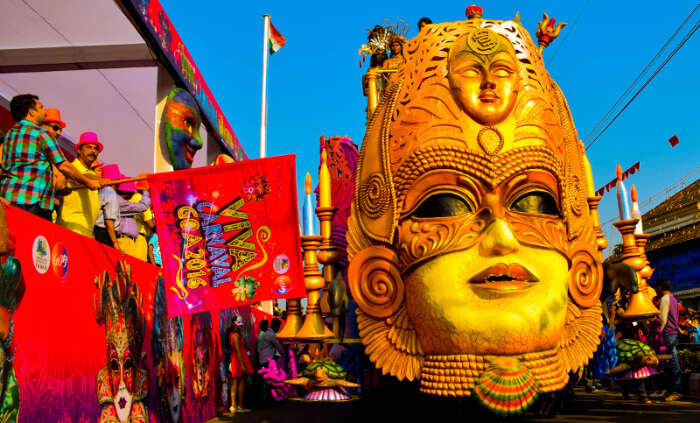We all have heard and know about the famous Rio de Janeiro Carnival. It is said to be the world’s biggest carnival and is also nicknamed as ‘the biggest show on earth’. Have you heard of Goa Carnival though?
And why one shouldn’t call it one! The carnival sees a crowd of 2 million people on the streets every single day. Crazy right?
Similarly, Carnival takes place in the Indian state of Goa. Yes definitely it is not anywhere as big as the one in Rio but it is THE ONLY carnival that happens in all of Asia.
There definitely aren’t 2 million people on the roads, there still are thousands of locals, travelers, artists and performers groove to the booming music on the streets of Goa during the Carnival.

Origins of Carnival in Goa
There are various descriptions for the origins of Carnival. In the pre-Christian era Carnival marked beginning of spring and the end of winter. It is believed that the winter spirits ruled the earth and had to be driven off to allow the spirits of summer to come in.
It was a rite of passage, a transformation from dark to light. Moreover all the winter stores had to be consumed, as they would now begin to spoil with the warmer weather, and a period of fasting would begin, until spring brought the ability to lay in new stores of food.
After the spread of Christianity, Carnival came to be held in the 3-4 days before the Lenten season, which is traditionally a period of 40 days before Easter when the people fast, or prefer not consuming meat and alcohol to commemorate the 40 days that Jesus spent fasting in the desert. This then was a period of final celebrations, one last humongous party, before the Lenten penitence began.
King Momo
King Momo is considered the king of Carnivals in various Latin American festivities, majorly in Brazil and Colombia and even in the Indian state of Goa and derived from the Greek God Momus. His appearance is the sign of the beginning of the Carnival festivities. Each carnival has a different King Momo, who is often given the key to the city. Traditionally, a tall, fat man is chosen to fulfill the role because the original King Momo was of that physical stature.

Carnival in Goa Every Year
While the origin of the Carnival in Goa date back to the time when Roman Catholic Church was introduced during the Portuguese conquest of Goa, the festival itself fell into obscurity during the later days of colonialism, as Portugal’s authoritarian regime known and is celebrated on the same day as Portugal Estado Novo limited freedom of assembly and press.
In the year 1961 when Goa was finally free from the Portuguese rule, the festival was restored to life by Timoteo Fernandes in 1965, a Goan musician who patterned the Goan Carnival after the famed Rio Carnival. Today, the Carnival parade includes floats from local villages, commercial entities, and cultural groups. It is still organised in a very traditional manner, including by the staging of streetside local plays which are commonly known as ‘Khell Tiatr’, in the coastal taluka of Salcete. Government of Goa’s Department of Tourism says that, “Goa’s most famous festival of Carnival has been celebrated since the 18th century.”

The Carnival usually starts off on Fat Saturday and ends on Fat Tuesday, just one day before Ash Wednesday and the first day of the Catholic season of Lent. In Panjim, the capital of Goa, the festival is accompanied by “Grape Escapade”, a local Wine festival, and a dance at Samba Square in the centrally-located Garden of “Garcia da Orta”.
According to local tradition, during Carnival Goa is taken over by King Momo, usually a local resident who presides over the festival during the 4-day span. King Momo traditionally proclaims the Konkani message “Kha, piye aani majja kar” which simply means “Eat, drink and make merry”.


